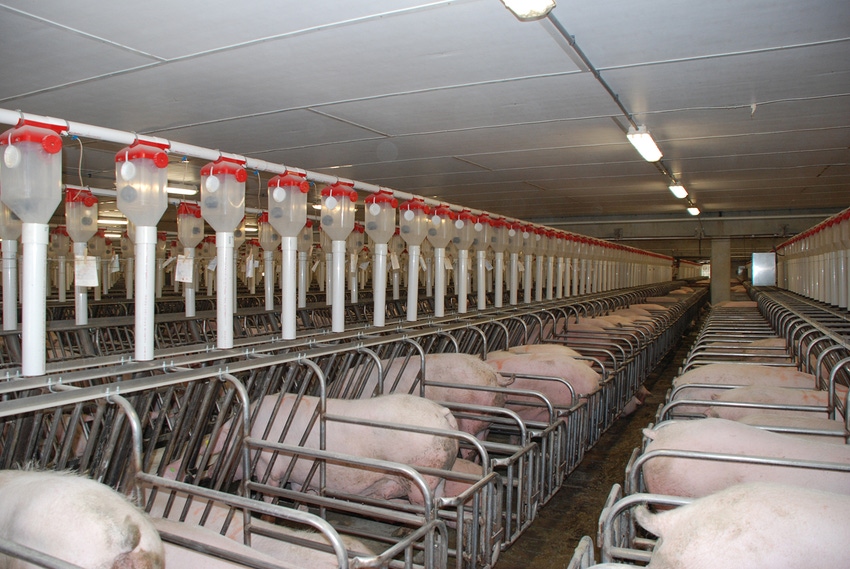Dealing with discharges in the sow barn
Missouri pork producer shares his perspective on the continuous fight.

It was Week 4, 2018 in the sow barn at Pine View Pork, when Adam Ruoff took a call from his breeding manager about elevated discharge levels. The northwest Missouri farm had always had a little light discharging, but nothing this heavy before.
“It was a puddle of the yellow pudding looking stuff and just very heavy discharge. This wasn’t the norm for us on our farms,” Ruoff says. “We decided to give it a day or two and then see what happens. A couple days down the road we’ve had anywhere from one to seven discharges per day on bred sows.”
Ruoff, who has been farm manager on his in-laws’ 4,200-head sow farm since 2014, soon reached out to the Carthage Veterinary Service team for assistance. They went over all the clinicals, but nothing really pointed to any contributing factor. Feed samples were sent off for testing as well as fetuses from aborts and mummies. Testing for porcine circovirus 2 and porcine circovirus 3 came back negative.
“It left us scratching our head,” Ruoff says. “The prevalence of the discharge kind of worked itself back down to a manageable level on its own, but then all of a sudden we did week 38, 39 and they exploded again.”
During Week 39, the Carthage team took post cervical artificial insemination samples of discharge and it came back as Trueperella. The team decided to pulse 10 grams chlortetracyline (CTC) in sow farrowing and gestation for two weeks the first part of November.
“On the treatment portion that had a short-term decrease, but there wasn’t anything solid. I mean we had a week or two, but now and again, it came right back,” Ruoff says. “We did have a noticeable increase in production in the farrowing house. Those sows seem to perform quite a bit better with that drug introduced there, but it’s just been from there, up and down and nothing.”
In December, Carthage veterinarians Joe Connor and Clayton Johnson paid a visit to Pine View Pork to do some more testing. Feed and water were sampled as well as urine pH. What they found was the sows that were discharging had a relatively basic pH, anywhere from 8 to 12. The team decided to run a pulse of a Kemin product at 25 grams per sow per day for 10 days in February.
“Once again, a decent decrease for a little short period of time and then it came right back up,” Ruoff says. “Fast forward to today, we’re still facing a discharge issue.”
Over the last year, some weeks the farm has seen five to 16 cases of discharge, while another week there may be none.
“Just when you think we’ve got a big problem, that’s a slow period the next week and you’re right back down,” Ruoff says. “So, we’re just kind of left chasing our tail and wondering what we can actually do for home treatments. Can we afford to keep doing things? It’s just been nerve wracking and it’s a nickel-and-dime thing.”
The Pine View Pork and Carthage team decided to focus their efforts on prevention for the whole farm, as 60% of the discharges were happening around the 30-day mark in farrowing and mid- to late-gestation were having fewer cases. The team looked at barn sanitation management, breeding practices and timing, and farrowing and sleeving practices. Urine pH and water quality were again monitored. Everything once again checked out fine.
While the farm hasn’t found a “magic remedy” to the discharge challenge, the experience has forced the team to make some management decisions such as: what to do with the discharge sow, how do they handle the fall out and what is the actual fall out, and how much can you spend on treatment and prevention.
On top of the discharge issue, Pine View Pork also had a porcine reproductive and respiratory syndrome break. Typically, Ruoff says the farm shoots for a 90% farrowing rate, but during the week of the break that went down to 76%.
“Our normal for our farm isn’t the normal anymore; it hasn’t been for a while. We’re having to do things differently to manage around this, but it’s coming around,” Ruoff says. “The last 16 weeks we’ve been running around 186 sows through the farrowing house at an 88% farrowing rate. It’s not perfect and it hasn’t been easy, but it could’ve been a total nightmare with lackluster management working around these problems.”
Ruoff challenges other producers to take a step back and look at their management systems to see if it is prepared for a situation like this.
“Discharges are a problem on our farm now, and you know, every situation’s going to be a little bit different,” Ruoff says. “Are you prepared for a challenge like this to pop up that you don’t have direct answers for, that you don�’t have the direct treatment for and how will you manage it correctly?”
About the Author(s)
You May Also Like





